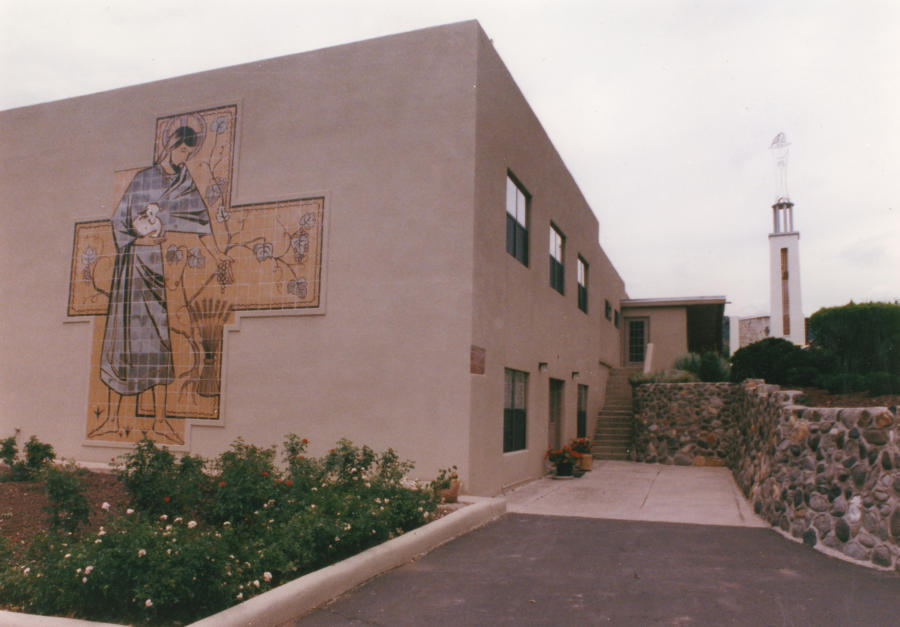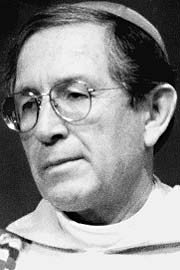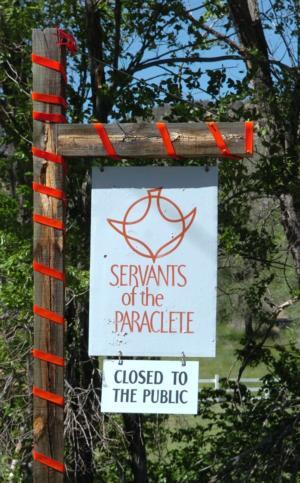Pedophile Priests and Servants of the Paraclete
By Mike Gallagher
Roman Catholic bishops in Pennsylvania used a treatment center in Jemez Springs for decades as a “laundry” to recycle priests who abused more than 1,000 children so they could return to their parishes in their diocese back home, according to a Pennsylvania grand jury report released this month. Only one of the more than 300 priests mentioned in the grand jury report stayed in New Mexico, briefly, after being sent for treatment at the Servants of the Paraclete foundation in Jemez Springs that operated from 1947 until it closed in the 1990s. The grand jury found that sending priests to the foundation was part of the systematic cover-up to protect priests accused of sexually assaulting children that extended back to the 1950s. At least 12 priests from the six dioceses in Pennsylvania were sent to the New Mexico facility over the years. Parishioners in Pennsylvania were told that priests sent to the Paraclete and two other church facilities in other states were on “sick leave” or suffering from “nervous exhaustion.” In some cases they were told nothing at all. “Put plainly, these institutions laundered accused priests, provided plausible deniability to the bishops, and permitted hundreds of known offenders to return” to active ministry, the grand jury report says. Pennsylvania’s Catholic bishops were not alone. For decades, priests accused of child sexual abuse were sent to the Servants of the Paraclete by bishops from around the country. Some priests remained in New Mexico, but many others returned to their home dioceses and were transferred to different churches. New Mexico has wrestled with the fallout of its own Catholic Church sexual abuse scandal since the early 1990s. Archbishop John C. Wester said in a statement issued Wednesday in reaction to the grand jury report, “Once again, we find ourselves reeling from the shocking and horrific revelations of sexual abuse of children and young people by the clergy.” Wester, who oversees the Archdiocese of Santa Fe, said, “A very deep and profound wound has been reopened,” but he recounted steps church officials have made to prevent systematic child sexual abuse and cover-ups from reoccurring here. In the early 1990s, several dozen civil lawsuits were filed in New Mexico claiming sexual assaults by priests in the Santa Fe Archdiocese and who had been treated at the Servants of the Paraclete. Most of those cases were settled out of court and the terms of the settlements were confidential.
Several priests were prosecuted, but most of the national attention focused on Archbishop Robert Sanchez of Santa Fe, who admitted having improper relationships with young women in the late 1960s and early 1970s. He resigned his office 1993. Between 2010 and 2015 more than 60 additional lawsuits were filed in New Mexico and records of past cover-ups were unsealed. In 2017, the Santa Fe Archdiocese published a list of 74 clergy members who have been credibly accused of sexually abusing children in New Mexico. At that time, 38 of the priests had died. The release of the list in New Mexico has led to another round of lawsuits against the archdiocese as more victims came forward. The Pennsylvania grand jury also profiled many priests who had died. “We decided it was crucial to include them anyway, because we suspect many of their victims are alive,” the report said. ‘Self-reports’ by priests There have been two other grand jury investigations of child sexual abuse by Catholic priests in Pennsylvania but the latest is by the far the most extensive, naming bishops and archbishops involved in helping to cover up allegations of sexual abuse. The report was issued as the Catholic Church was rocked by allegations involving bishops in Chile and the resignation of Cardinal Theodore E. McCarrick, who stepped down from the College of Cardinals after it was revealed he was alleged to have sexually abused minors and young seminarians in New Jersey. The other two facilities used by Pennsylvania bishops to launder priests were St. John Vianney Center in Downingtown, Pa., and St. Luke’s in Suitland, Md. The bishops sent the priests for “evaluation” at church-run psychiatric treatment centers, and once there they were evaluated based on their “self-reports” – regardless of evidence the priest had actually engaged in sexual contact with a child, the grand jury found. When a priest denied allegations he usually avoided any diagnosis related to the sexual abuse of children, such as being labelled a pedophile. These institutions focused on a clinical diagnosis instead of the actual behavior as reported by the victims. ‘Serious’ red flag Father Edward R. Graff left the Diocese of Allentown, Pa., in 1992 and was sent to the Servants of the Paraclete for treatment of undefined but “serious” conduct after 35 years in the diocese. There had been a series of letters between then-Bishop Thomas Jerome Welsh of Allentown and then-Santa Fe Archbishop Sanchez about Graff and the “seriousness” of his case, but no details were contained in the letters. The grand jury found that vague language was typical of Welsh’s correspondence when it came to Graff, always expressing concern about legal liability if something “untoward” happened involving the priest.
Welsh authorized Graff to retire from active ministry in Pennsylvania but allowed him to “minister” to the needy in the Santa Fe Archdiocese under supervision by the Servants of the Paraclete. Graff’s pension, living allowance, and insurance for health, life and automobile would be carried by the Allentown diocese even though he was in New Mexico, according to the correspondence. Although it is known Graff went to Servants of the Paraclete, he does not appear on any records as having been attached to any New Mexico church or conducting any ministry here. He is not on the Santa Fe Archdiocese list of priests against whom there are credible accusations of sexual abuse, but in 1993 he showed up working as a priest in a small town near Amarillo. The bishop in Amarillo, according to the grand jury report and attached correspondence, wasn’t in on the deal. He thought Graff was a recovering alcoholic and assigned him to work at a parish “where he was much loved by the people.” Graff later worked at missions in the diocese in poor Hispanic communities because he spoke Spanish. Allentown Bishop Welsh later wrote to his Texas counterpart that he needed to keep watch on Graff because of the “known risks” and potential legal liability Graff presented. The correspondence between Sanchez and the Pennsylvania bishop in 1992 came at a time when dozens of lawsuits were filed against the Archdiocese of Santa Fe and the Servants of the Paraclete. Criminal charges had been brought against priests and the local news media covered the lawsuits and resulting scandals extensively. Whether that had anything to do with Graff leaving the state after he was at the Paraclete is not known. Years passed. Sanchez had resigned and both the Pennsylvania and Texas bishops had retired, replaced by men who according to the grand jury report knew little or nothing of the “seriousness” of Graff’s case. In October 2002, Graff was arrested in Briscoe County, Texas, for sexually abusing a 15-year-old boy. He died “due to injuries suffered in an accident” while in jail awaiting trial. After reports of the charges against Graff, at least four men came forward alleging they had been sexually abused by Graff in the 1970s and 1980s when he was a priest in the Allentown diocese. Paraclete vs. prison Father Robert Caparelli never made it to the Servants of the Paraclete in 1993 despite the efforts of Bishop James C. Timlin of Scranton, Pa. The grand jury report found that Caparelli was among a number of priests who “highlight the wholesale institutional failure that endangered the welfare of children throughout Pennsylvania.” Caparelli was ordained a priest in Scranton in 1964, and within four years a police officer in Hazelton, Pa., reported to the bishop at the time – a position Timlin would hold later – that Caparelli had molested two altar boys. The officer wrote that the boys’ mother did not want to press charges because if her husband found out, Caparelli could get killed. The grand jury found that records showed Caparelli’s superior believed the priest was under the control of an “incubus,” a Latin term for a male demon obsessed with sexual matters. According to the report, then-Monsignor Timlin was aware of concerns about Caparelli. In 1991, Caparelli was charged with 32 counts involving sexual abuse of minors. After the initial indictment, more victims came forward and additional charges were filed. Caparelli pleaded guilty and was awaiting sentencing in 1993 when now-Bishop Timlin wrote the judge in Caparelli’s case a letter suggesting that instead of sending Caparelli to prison he be sent for treatment to a facility in New Mexico that specialized in “these cases.” At the time the letter was written the Servants of the Paraclete were facing a growing number of civil lawsuits filed by New Mexico victims of sexual abuse by priests who had been treated there. Timlin wrote the judge that it would be a financial savings to the state government. At the time of the letter, the diocese was fighting lawsuits filed by Caparelli’s victims. The judge wasn’t swayed by the bishop’s letter. He sentenced Caparelli to prison, where it was discovered he had been HIV-positive for years. He died in 1994 in prison.
|
.
Any original material on these pages is copyright © BishopAccountability.org 2004. Reproduce freely with attribution.


